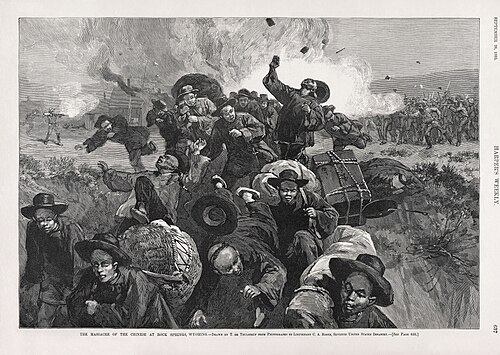| Rock Springs massacre | |
|---|---|
 An illustration of the massacre from an 1885 issue of Harper's Weekly | |
| Location | 41°35′28″N109°13′8″W / 41.59111°N 109.21889°W Rock Springs, Wyoming Territory, U.S. |
| Date | September 2, 1885 7:00 a.m. – late night (UTC-6) |
Attack type | Mass murder, massacre, riot |
| Weapons | Various |
| Deaths | At least 28 immigrant Chinese miners (some sources indicate as many as 40 to 50 died) |
| Injured | 15 |
| Victims | Chinese immigrant miners |
| Perpetrators | European immigrant miners |
| Motive | Ethnic hatred (anti-Chinese sentiment) and economic competition |
The Rock Springs massacre, also known as the Rock Springs riot, occurred on September 2, 1885, in the present-day United States city of Rock Springs in Sweetwater County, Wyoming. The riot, and resulting massacre of immigrant Chinese miners by European immigrant miners, was the result of racial prejudice toward the Chinese miners, who were accused of taking jobs from the existing miners. The Union Pacific Coal Department found it economically beneficial to give preference in hiring to Chinese miners, who were willing to work for lower wages than their European counterparts, which angered the existing miners. When the rioting ended, at least 28 Chinese miners were dead and 15 were injured. Rioters burned 78 Chinese homes, resulting in approximately $150,000 in property damage [1] [2] [3] (equal to $4,800,000 in 2024 terms). [4] Despite the identification of the perpetrators, no individuals were prosecuted for the murders or property destruction. [5] [6]
Contents
- Background
- Causes
- Massacre
- Chronology
- Names of the dead
- Outcome
- Immediate aftermath
- Arrests
- Diplomatic and political issues
- Reaction
- Post-massacre violence
- Significance and context
- Location
- See also
- References
- Notes
- Sources
- Further reading
- External links
Tension between European and Chinese immigrants in the late 19th-century American West was particularly high, especially in the decade preceding the violence. The massacre in Rock Springs was one among several instances of violence culminating from years of anti-Chinese sentiment in the United States. The Chinese Exclusion Act in 1882 suspended Chinese immigration for ten years, but not before thousands of immigrants came to the American West. Most Chinese immigrants to Wyoming Territory took jobs with the railroad at first, but many ended up employed in coal mines owned by the Union Pacific Railroad. As Chinese immigration increased, so did anti-Chinese sentiment on the part of white Americans. The Knights of Labor, one of the foremost voices against Chinese immigrant labor, formed a chapter in Rock Springs in 1883, and most rioters were members of that organization. However, no direct connection was ever established linking the riot to the national Knights of Labor organization. [1]
In the immediate aftermath of the riot, United States Army troops were deployed in Rock Springs. They escorted the surviving Chinese miners, most of whom had fled to Evanston, Wyoming, back to Rock Springs a week after the riot. Reaction came swiftly from the era's publications. In Rock Springs, the local newspaper endorsed the outcome of the event, while in other Wyoming newspapers, support for the riot was limited to sympathy for the causes of the existing miners. [2] The massacre in Rock Springs touched off a wave of anti-Chinese violence, especially in the Puget Sound area of Washington Territory. It is also the worst mass shooting in Wyoming history.






